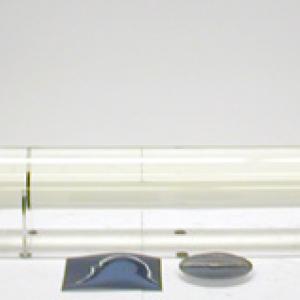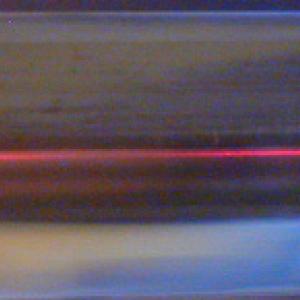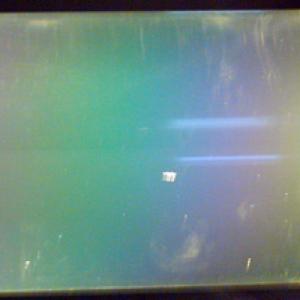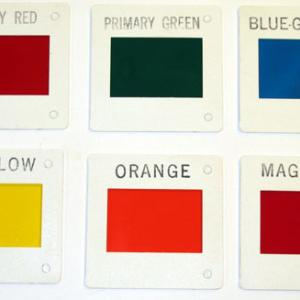College of Liberal Arts & Sciences
6H30.30 - Polarization - Karo Syrup Tube
Place the laser so that it shines down the length of the tube filled with Karo Syrup. Place one polarizing sheet between the laser and the tube. Darken the room and a series of maximums and minimums will be observed the length of the tube. If you view a maximum from the side and then move so that you are viewing the same spot from the top you will find that the maximum has turned into a minimum due to the optical rotation of the Karo Syrup. Replace the laser with a slide projector and you will see a rainbow spiral down the length of the tube.
NOTE: Only secondary colors are seen here. Also by rotating the polarizing plate you may make the colors or the maximums and minimums of the laser beam travel down the length of the tube.
NOTE: Do not bring the 1000 watt bulb slide projector too close to the polarizing plate as the heat generated will melt the plate. A regular slide projector will work in this situation, the colors will be just less intense.
An interesting effect can be observed by placing filters in the light beam or in the slide projector itself. Instead of a barber pole type rainbow, you will see dark bands in the rainbow corresponding to the colors that are absorbed by the filter.
If you happen to have two tube available for this experiment you could try filling one with a solution of D-Fructose (Levulose) and one with D-Glucose (Dextrose) with concentrations of 1 to 5 g / 100 ml of solution. The D-Fructose should have polarization angles between -92 and -133.5 degrees. The D-Glucose solution should have polarization angles between +52.7 to +122. Both of these sugars have chemical formulas of C6H12O6.
- Paul Changnon, "Animated Displays IV: Linear Polarization", TPT, Vol. 31, # 8, Nov. 1993, p. 489.
- G. R. Davies, "Polarized Light Corridor Demonstration", TPT, Vol. 28, # 7, p. 464, October 1990.
- Wallace A. Hilton, "An Optical Lever for the Faraday Effect Experiment", TPT, Vol. 9, # 6, Sept. 1971, p. 346
- P.R. Berman, "Optical Faraday Rotation", AJP, Vol. 78, # 3, March 2010, p. 270.
- Kam L. Yan, W. P. Lonc, S. J., "Microwave Faraday Rotation", AJP, Vol. 43, # 8, Aug. 1975, p. 718.
- W. S. Moore, "A Multipurpose Laser Demonstration Experiment", AJP, Vol. 39, #12, Dec. 1971, p. 1536.
- W. S. Porter and E. M. Bock, Jr., "Faraday Effect in a Plasma", AJP, 33, # 12, Dec. 1965, p. 1070.
- Om-16, 18: Freier and Anderson, A Demonstration Handbook for Physics.
- O-685: "Three Compartment Tank", DICK and RAE Physics Demo Notebook.
- O-690: "Karo in Beaker - Barber Pole", DICK and RAE Physics Demo Notebook.
- L-129: Richard Manliffe Sutton, Demonstration Experiments in Physics.
- T. Kallard, "Simple Polarization Demonstrations", Exploring Laser Light, p. 88.
- Yaakov Kraftmakher, "4.5, Faraday Effect", Experiments and Demonstrations in Physics, ISBN 981-256-602-3, p. 249.
- 5.54: Jearl Walker, "Optical Activity of Karo Syrup", The Flying Circus of Physics with Answers.
- Ron Hipschman, "Rotating Light", Exploratorium Cookbook II, p. 98.1 - 98.4.
- "Rotating Light", Exploratorium Science Snackbook, p. 85.1 - 85.2.
- Zigmund Peacock, "Rotation of the Electric Field in Polarized Light a Demonstration", PIRA News, Vol. 6, # 2, October 1991.
- Hollis N. Todd, Polarization of Light: Basic Theory and Experiments, Cambridge Instruments Inc., 1970.
- Jim McConville, "Faraday Rotation as a Corridor Demonstration", PIRA News, Vol. 6, # 6, June 1992.
- Jearl Walker, "An Inexpensive Homemade Polarimeter Can Analyze Optically Active Compounds", The Amateur Scientist, Jan., 1986.
- Brian Jones and Matt Fackelman, "Colorful Karo", Don't Forget the Duct Tape, p. 21 - 24.
- Joseph Frick, "Circular Polarization in Liquids", Physical Technics, J.B. Lippincott & Co., 1861, p. 240.
- Optical Rotation, Wikipedia, https://en.wikipedia.org/wiki/Optical_rotation.
Disclaimer: These demonstrations are provided only for illustrative use by persons affiliated with The University of Iowa and only under the direction of a trained instructor or physicist. The University of Iowa is not responsible for demonstrations performed by those using their own equipment or who choose to use this reference material for their own purpose. The demonstrations included here are within the public domain and can be found in materials contained in libraries, bookstores, and through electronic sources. Performing all or any portion of any of these demonstrations, with or without revisions not depicted here entails inherent risks. These risks include, without limitation, bodily injury (and possibly death), including risks to health that may be temporary or permanent and that may exacerbate a pre-existing medical condition; and property loss or damage. Anyone performing any part of these demonstrations, even with revisions, knowingly and voluntarily assumes all risks associated with them.



